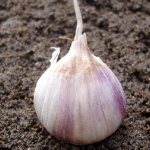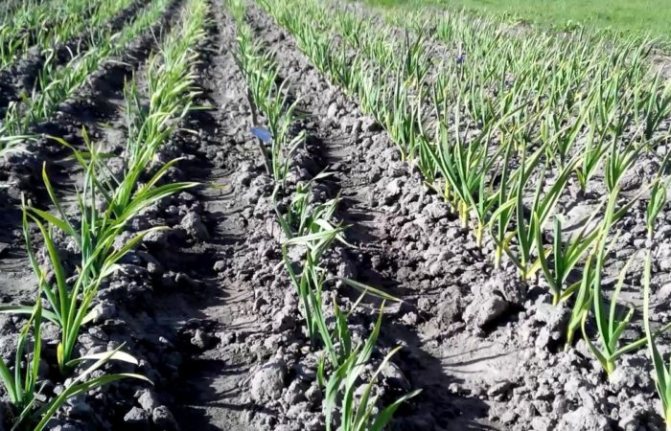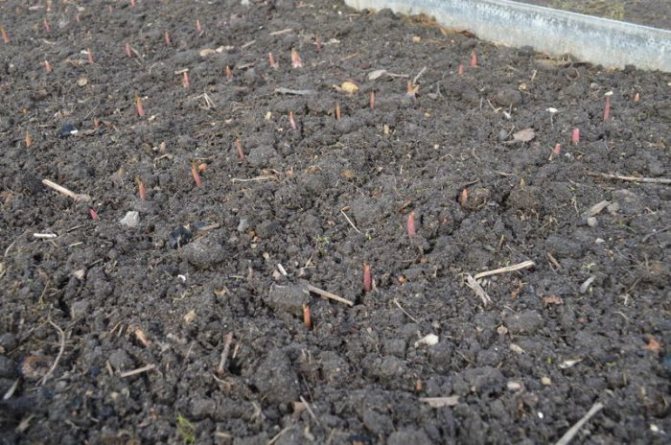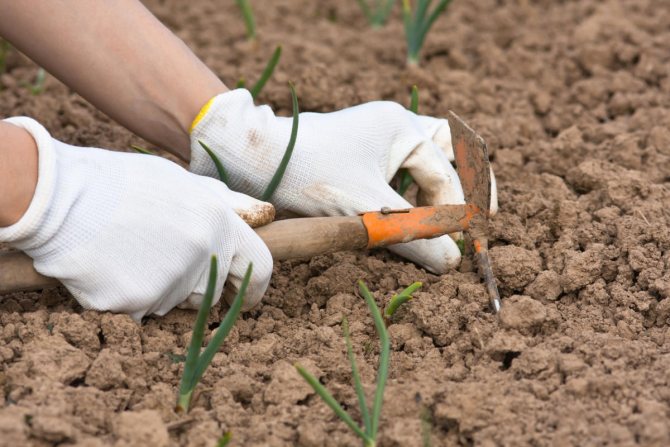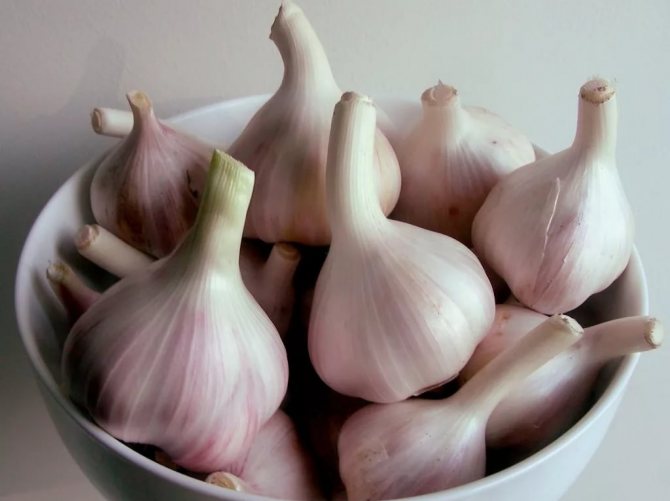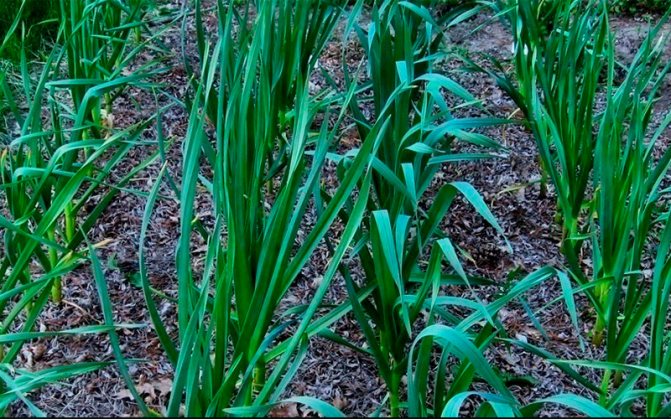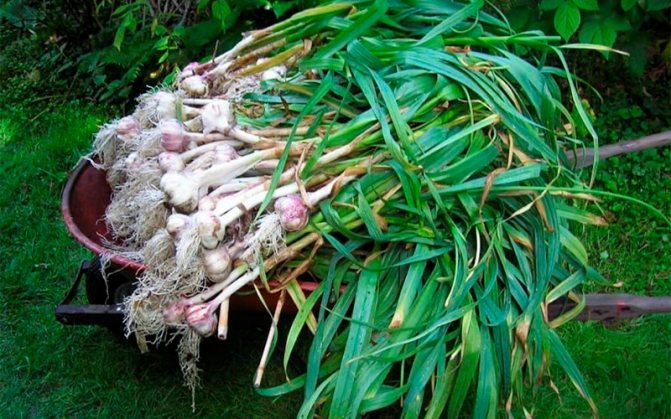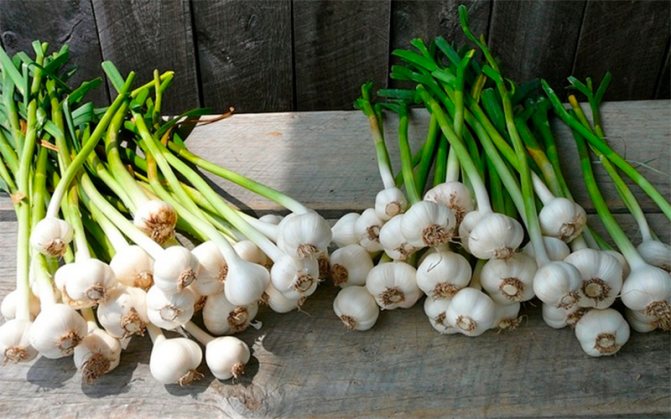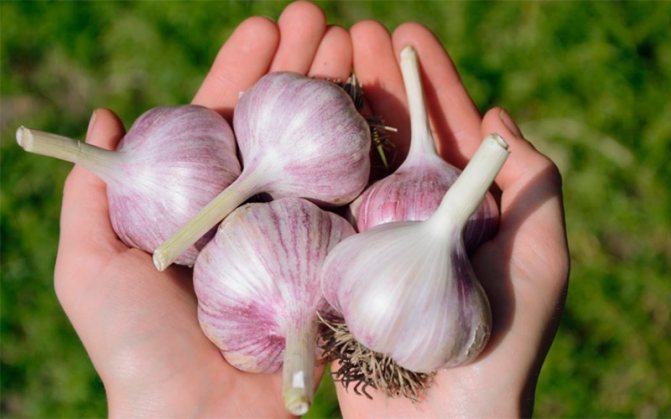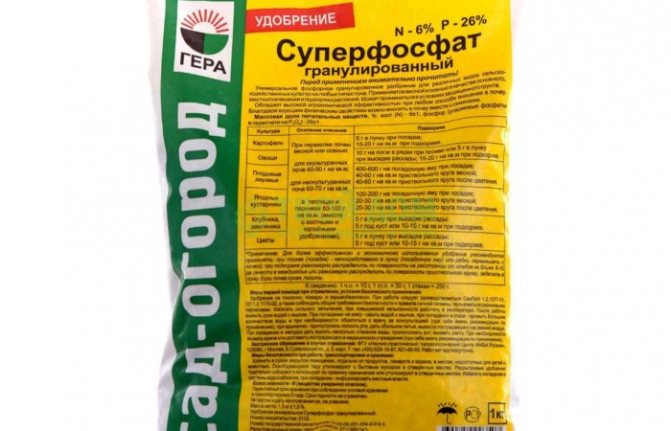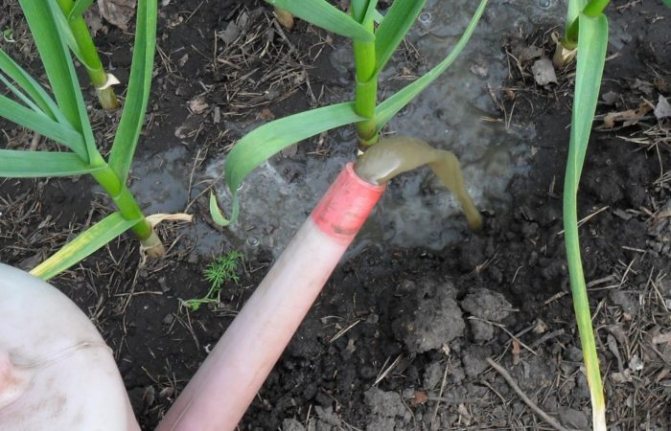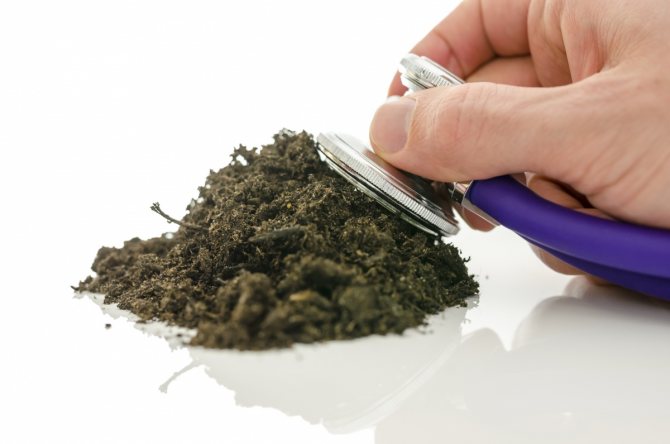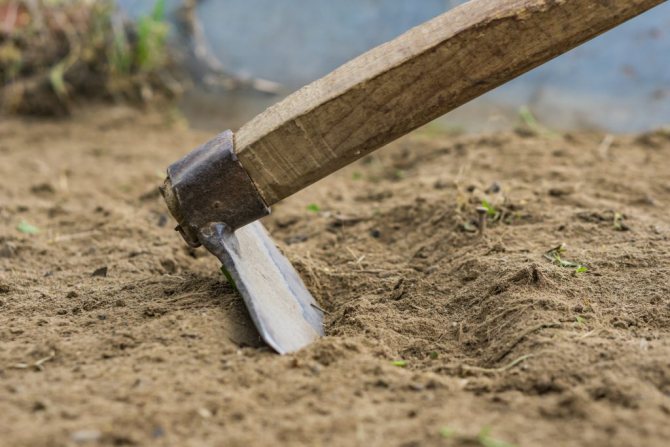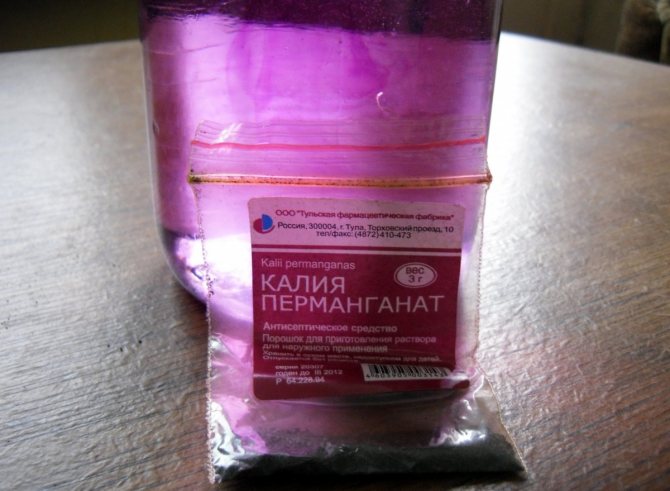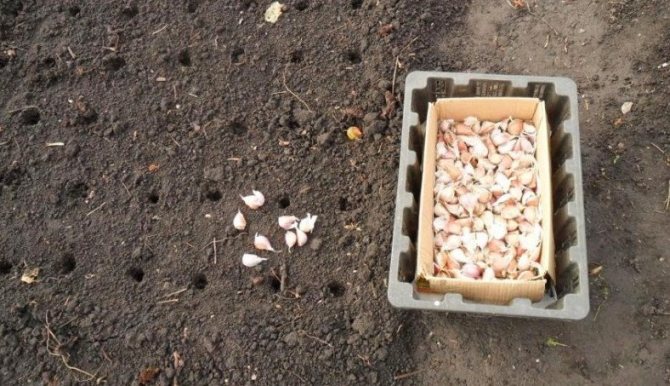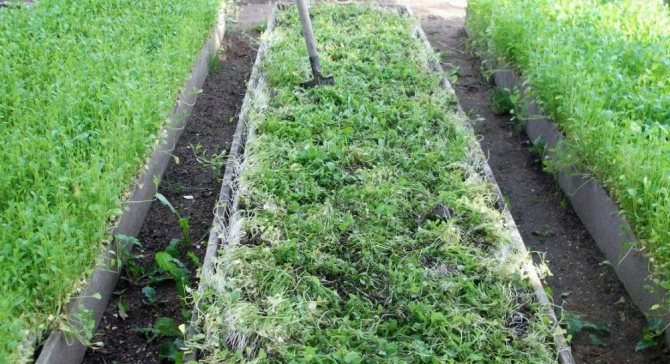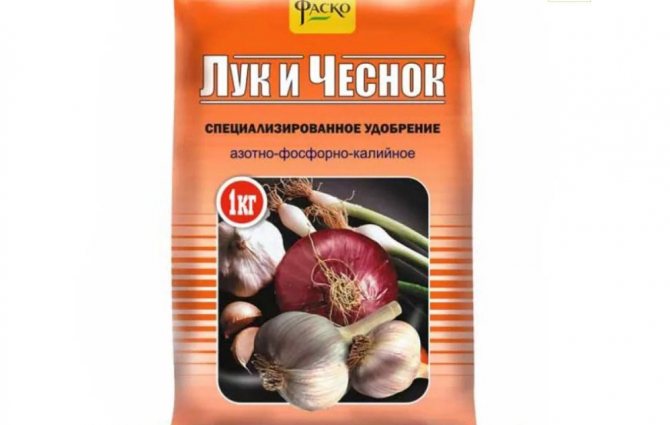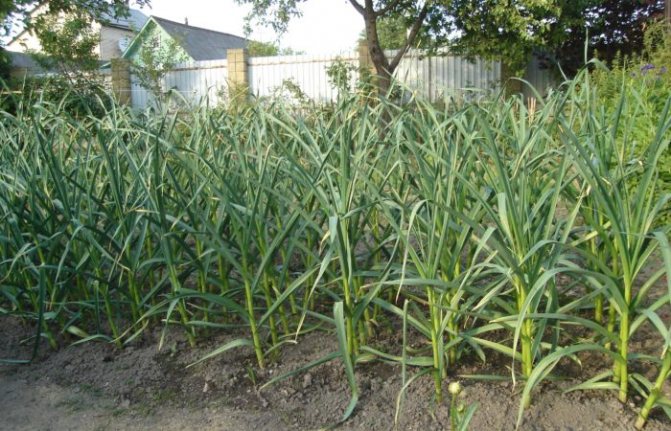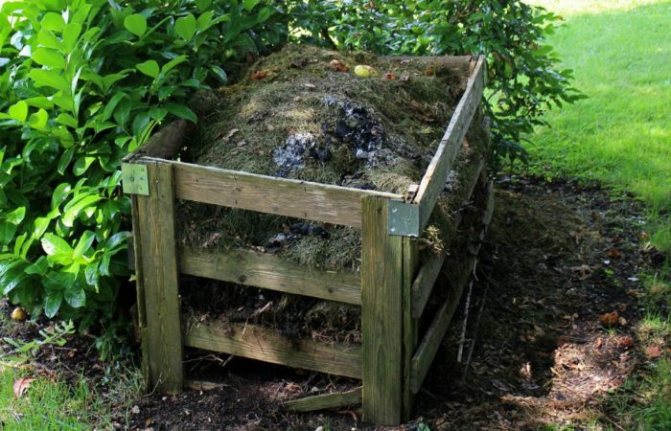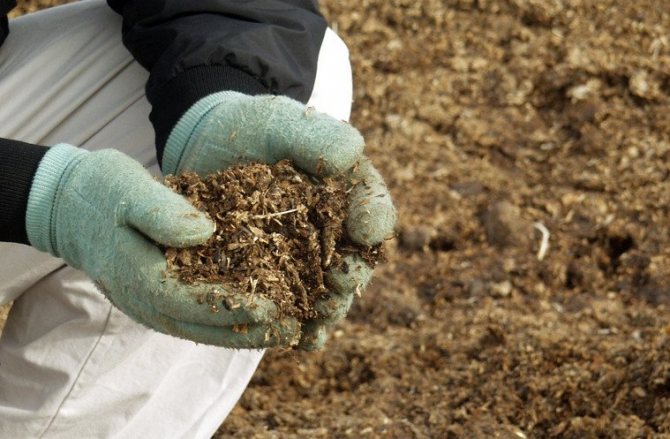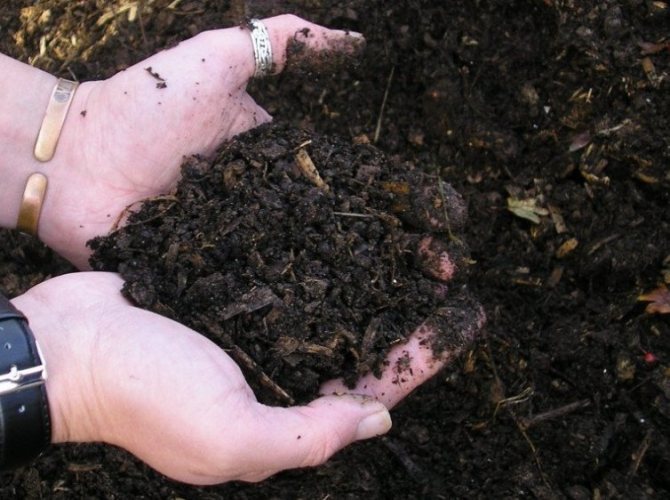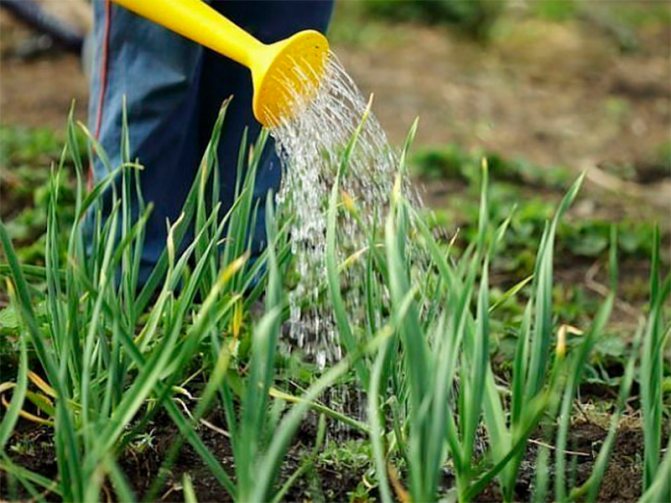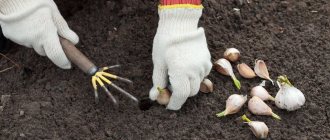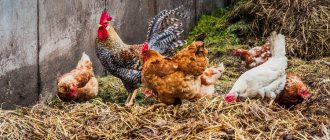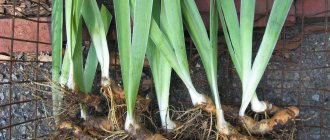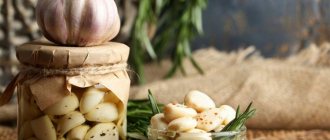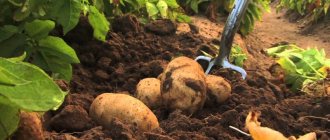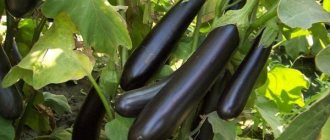Preparatory autumn activities for the garlic bed
Before planting garlic, it is necessary to prepare a garden bed in advance, several months in advance. The place planned for landing is dug to the depth of the shovel bayonet... If the soil is clay, add peat: for each meter of the bed 1 bucket.
If the soil is loamy, add 3 kg of compost and humus, 1 tbsp. l. superphosphate and 200 g of lime. This is done so that the earth has time to settle, and the fertilizers applied begin to interact with it. If the soil is peaty, loam is added, and clay and peat are added to the sandy soil.
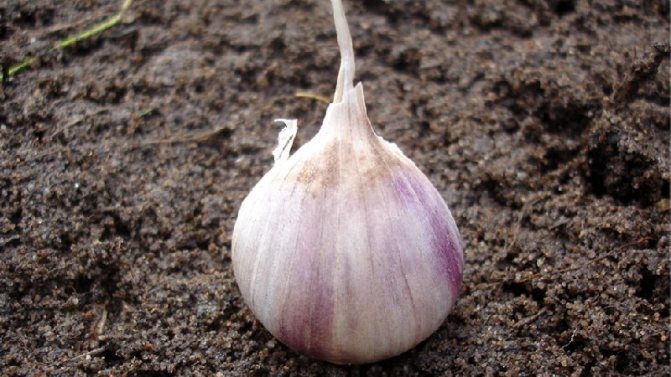
After adjusting the composition of the soil, the bed is treated with a solution of copper sulfate... The solution is prepared by mixing 10 liters of water and 1 tbsp. l. copper sulfate. They are processed at the rate of 1 liter of solution per 1 m of the site.
Reference. After all the preparatory work has been completed, the area is covered with a film.
The plot for the garden should be chosen where there is a lot of sun... The place should not be constantly humid so that the roots of the garlic do not rot. The site in the lowland is not suitable because of the accumulating melt water. A site on a hill is also not recommended to use, since in winter the snow from such a place will be blown away by the wind, and the garlic may freeze.
Preparing the soil for planting
Garlic, along with other crops, should be included in a 4-5 year crop rotation cycle, the best predecessors are cucumbers, zucchini, legumes, early or cauliflower, early greens, salads. The bed must first be disinfected with a solution of copper sulfate - 1 spoon per bucket of water.
Then the earth needs to be dug up to a depth of about 20 cm, removing weeds and their roots, generously fertilizing with humus. For 1 sq. m, at least 5 kg of rotted humus or compost is introduced, adding 20 g of superphosphate and a glass of wood ash to it. After that, the soil is well watered and covered with a film for a while. Until the cloves are planted, the soil will remain loose, saturated with oxygen and slightly settle.
Basic fertilizers for garlic
Fertilizers when planting garlic play one of the main roles... The culture is in dire need of nutrients for growth.
There are the following types of feeding:
- Dolomite flour or lime. Introduced into the soil to reduce acidity. The dosage depends on the acidity of the soil. In some cases, wood ash can be used.
- Organic fertilizers. The best option is compost with manure and poultry droppings. Compost is useful for its content of assimilable nitrogen, potassium, sulfur, phosphorus and trace elements.
- Mineral fertilizers. The leader in this group is superphosphate. Wood ash can be used as the most affordable mineral fertilizer.
- Sulfur. This element is vital for the development and growth of garlic.
It can be useful:
How to properly plant garlic before winter
Planting garlic bulbs before winter
Secrets of winter garlic care in spring
Selection of predecessors
Observing the rules of crop rotation, you can achieve increased yields... The plant has a superficial root system, therefore it takes the substances necessary for development from the upper soil layer. Productive use of the soil after plants with a long root system.
The best predecessors are squash and squash, green manure - clover and alfalfa. A berry bush will be a good predecessor. A good option is soil after tomatoes, cucumbers, peppers, cabbage and pumpkin.
You can not plant garlic after onions, since these plants are attacked by the same pests.
Planting garlic near a bed of beans, peas or cabbage is not recommended... These crops do not tolerate the proximity of garlic - it interferes with their growth and development.
Attention! If there is not enough space at the summer cottage, you can find a way out by adding garlic to strawberries, cucumbers, currants, raspberries.
Preparing the soil for planting
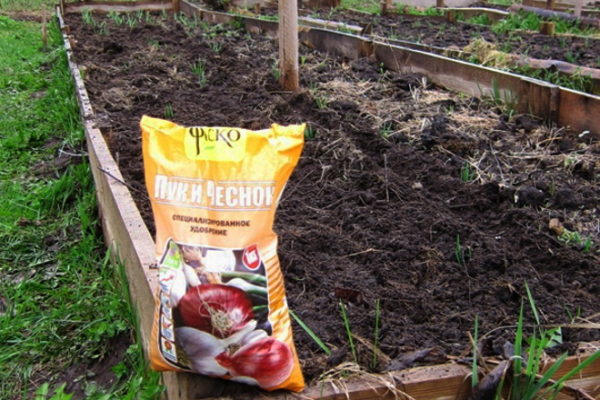

Along with other vegetables, garlic is included in the crop rotation cycle, which is 4 to 5 years. Its predecessors can be:
- all types of cauliflower;
- all types of salads and greens;
- cucumbers;
- squash.
First, the garden bed is disinfected by treating it with copper sulfate. To do this, prepare a solution in the ratio of 1 tablespoon to 10 liters of water. After processing, the soil is dug up. The digging depth should be 20 cm. At the same time, all weeds are removed together at the roots so that they do not drown out the young garlic.
The dug up soil is fertilized with humus or rotted compost, with the addition of superphosphate (20 g) and wood ash (1 glass). The prepared soil is watered abundantly and covered with polyethylene. So, the earth will retain its splendor, looseness, oxygen and will be completely ready for planting.
Determination of soil acidity
The best choice for garlic would be a neutral or slightly acidic soil.... When analyzing the acidity of the soil, the pH should be higher than the neutral indicator of 6.5. Weeds growing on the soil selected for planting serve as an indicator of acidity.
The fact that the acidity of the soil is increased is indicated by the presence of plantain, mint, buttercup. If the soil is neutral or slightly acidic, nettles, cornflowers, clover, chamomile grow on it.
There are ways to determine the acidity of the soil:
- Soil meter. With the help of a special device, you can accurately determine the condition of the soil.
- Vinegar. If you pour a handful of soil with vinegar, bubbles should appear on its surface. If this does not happen, then the acidity is increased.
- Currant, cherry or bird cherry leaves. The leaves of any of these plants are poured with boiling water, wait for the water to cool, and add soil to it. If the color of the water changes to red, then the acidity is increased. If it turns green, the soil is neutral. If the water turns blue, this indicates that the soil is slightly acidic.
When the soil is acidic, plants are unable to assimilate nutrients. Garlic roots hardly develop in acidic soils.
Testimonials
Vasily (Ryazan region)
“I grow winter garlic on the site. Usually, the harvest was small. The heads grew strong, but small. A neighbor advised me to fertilize the soil with wood ash. The result was excellent: the garlic grew large and juicy, without leaving the green mass. The result pleased me very much, now I fertilize the garlic with ash every year. "
“I decided to conduct an experiment in growing winter garlic and planted mustard in the garden. At the forum of gardeners I read that mustard is one of the best siderates. Everything has been confirmed in practice. I planted the mustard, then dug up the bed. Garlic not only endured the winter, but also pleased with its large fruits and excellent taste. "
When growing winter garlic, it is necessary not only to remove weeds and water the plant, but also to apply fertilizers. This work will certainly pay off: you will get a harvest of large garlic with excellent taste.
Garlic is one of the most popular crops, which is grown in their summer cottages by almost everyone. It is extremely beneficial for human health and at the same time is recognized as perhaps the most popular seasoning.
Any gardener strives to get the maximum yield, but this is not always possible. Timely fertilization with the necessary elements at the right time will help. Today we'll talk about when and how to fertilize garlic before winter.
Fertilizers that are suitable for winter garlic
Through the use of the correct feeding garlic will be able to accumulate more nutrients, the plant's immunity will be strengthened, and its resistance to pests and diseases will improve.
Mineral and organic fertilizers are used for winter garlic.... There are a number of ways to improve soil fertility when growing garlic.
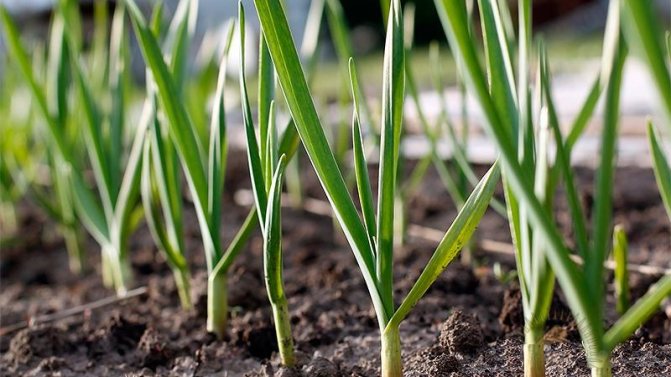

Improving the soil with green manure
The use of green manure will have a beneficial effect on the quality of the crop... Garlic grows well after such predecessors.
On a plot of land adapted for planting garlic, green manure plants need to be planted at the end of July... Barley, rye, mustard belong to siderates. Their roots and green mass contain phytoncides and essential oils that destroy viruses and fungi that infect garlic.
A few weeks before planting, the siderates are mowed and dug up... In this case, young shoots of green manure plants are left underground to rot. To speed up the decay process, the dug up bed is moistened. In the process of decomposition, the soil will be saturated with useful trace elements that are important for the development of garlic.
Improving the soil in this way is comparable in efficiency to using humus or compost. The soil becomes lighter, free-flowing and oxygenated.
Top dressing with chemicals
Chemical mineral fertilizers have a beneficial effect on the development of garlic heads... What fertilizer should be applied in autumn for garlic? Superphosphate and potassium salts are used before planting. With the help of potassium, it will be easier for the plant to survive the winter, as it has a beneficial effect on the formation of the root system.
Organic complexes
Agrochemicals can be replaced with natural fertilizers. Many gardeners do this, taking into account the centuries-old experience of feeding the fertile soil layer with compost and other compositions of organic fertilizers, which our ancestors successfully used.
Organic fertilizers:
- manure;
- compost;
- ash;
- yeast;
- ammonia.
Manure
The use of manure in the garden is a proven and effective method of feeding. Experienced gardeners use rotted mullein instead of fresh cakes, as fresh substrate can burn the tender equine system of the seedlings. Usually, manure is used before winter, so that during the cold season it has time to decompose in the ground and enrich it with useful substances. When watering with a diluted mullein, they are closely monitored so as not to fall on green shoots. For irrigation, a solution is made from part of the manure and seven parts of water.
Compost
Compost can be made from a variety of ingredients. Garlic is especially responsive to compost with added kitchen waste (potato skins, carrots, apples, etc.). Compost is introduced when digging the beds for planting.
Ash
Ash is used as a source of potassium and phosphorus. In early spring, it is not necessary to add ash fertilizers, since there are no nitrogenous compounds in them. Ash is used in different ways:
- scattered over the beds;
- make a solution (half a liter per bucket of water);
- process the leaves of seedlings to protect against pests.
Spreading dry ash over the leaves of the seedlings in dry weather will protect them from garden pests and mold.
Garlic yeast dressing
Yeast dressings are very popular among gardeners. Cultures grow "by leaps and bounds", become strong and hardy. Both fresh and dry ingredients are used to prepare the yeast solution. Take 200 grams of fresh yeast per liter of water, stir well and leave to stand for a day.Then the finished concentrate is diluted in a bucket of water and used to feed the garlic. Yeast dressing is used in spring and summer.
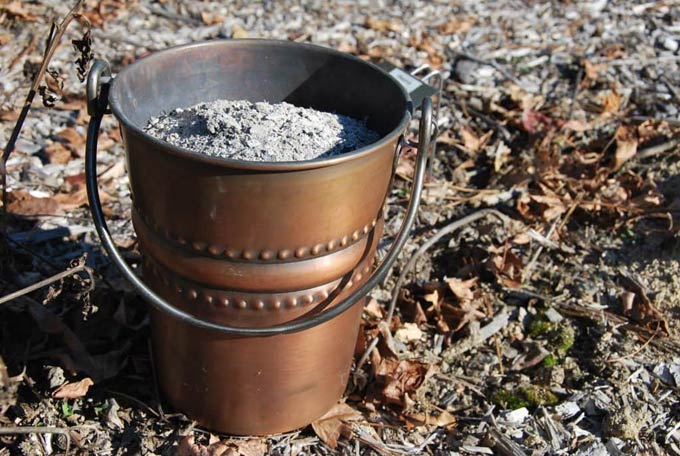

Ammonia
Modern gardeners recommend using pharmacy ammonia to nourish plants with nitrogenous compounds. To prepare a working solution for watering, one bottle of ammonia (50 ml) is enough for a bucket of water. For irrigation of green mass, make a less concentrated solution using 25 ml of ammonia per bucket. This solution nourishes the garlic with nitrogen and protects against pest aggression.
Features of foliar feeding
This method of feeding is used when the plant needs specific microelements.... It consists in applying fertilizer by spraying the outer part of the plant, which contributes to the faster assimilation of useful microelements.
Important! When spraying, a lower concentration of the solution is used than with the traditional method of feeding.
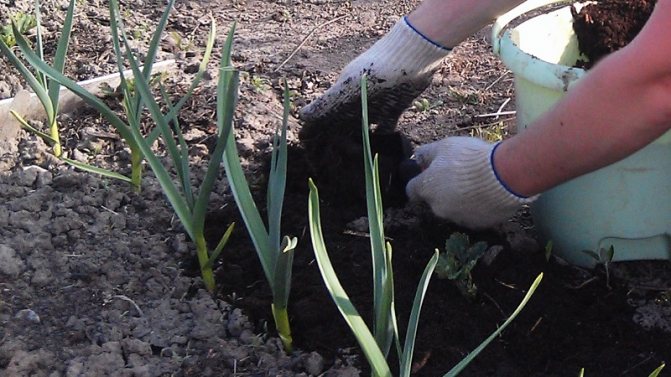

It is important to follow the rules for foliar feeding:
- Spraying with a fine dispersion spray.
- Do not oversaturate the fertilizing solution. Otherwise, you can burn the greens of the garlic.
- Frequent feeding is harmful. Foliar dressing is carried out three times.
- It is better to choose the time in the morning, if the weather is cloudy, or in the evening. It is important to consider that the leaves must dry before nightfall.
Siderata
Siderata is a green organic matter, it enriches the land, and also converts sparingly soluble substances into a form that the culture can easily assimilate. Siderata help to retain moisture in the soil, they loosen the soil, and reduce the number of weeds. Protects against nematodes.
Siderata for garlic - mustard, lupine, phacelia.
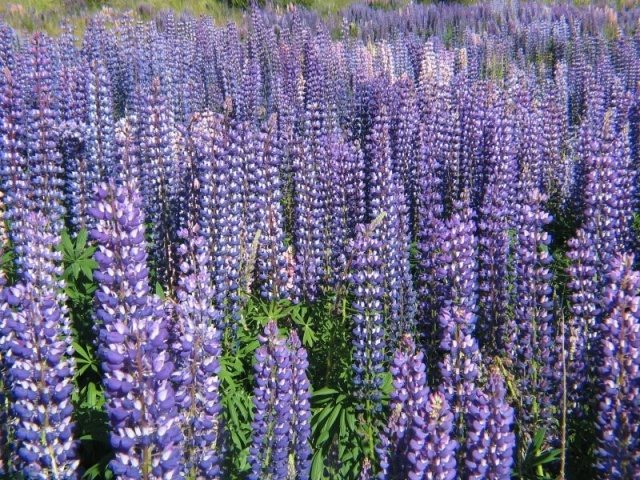

They are sown in early spring before planting the garlic, but after the soil has been fertilized with phosphorus and potassium. Siderates can accumulate nitrogen, phosphorus, potassium and transfer them. They enrich impoverished lands, loosen heavy soils, and prevent the leaching of useful elements.
When and how often to feed garlic: schemes
In the case of planting in the fall, garlic does not require enhanced nutrition.... But it is imperative to add humus to the soil in order to increase its fertility. Begin feeding the garlic after the snow cover has melted.
Throughout the season, feeding is carried out three times.:
- A few weeks after the snow melted. During this time, the garlic needs to be fed. Ovaries begin to form, and the plants will have to deal with the possible last frost. Fertilize with a solution of urea or boric acid. It doesn't hurt to add a manure solution.
- 3 weeks after the first feeding, to replenish the supply of trace elements in the soil. The most commonly used solution is boric acid. In rare cases, urea again. Again, a manure solution will not be superfluous.
- In the middle of summer, during the formation of the head of garlic to increase its size. For these purposes, a superphosphate solution is used.
Outcome
Growing garlic is not difficult if you follow the recommendations specified in the article exactly. It should be remembered that before planting seed material, the land must be carefully prepared and fertilized. Winter and spring garlic require the same fertilizer composition, but the timing of feeding is different. Both types of crops are fed immediately after the emergence of the first leaves, and then fertilized two more times with an interval of a month.
The first two dressings of garlic are aimed at activating the growth of green mass, the third dressing is aimed at the formation of a large head. As soon as the size of the head becomes the size of a walnut, potash and phosphorus compositions are added. Nitrogenous substances are not introduced during the formation of the head, since they activate the growth of leaves.Remember that plants are constantly drawing all nutrients from the fertile soil layer. If you do not make up for the deficiency of nutrients in the soil, seedlings grow weak. Timely feeding of crops will provide you with a rich harvest of fruits.
Seat selection
Preparing a bed for winter garlic in the fall begins with choosing a place for them. This bulbous culture does not take root in shaded areas and in lowlands with closely located groundwater.
The most suitable place for planting winter varieties of garlic will be the southern section of the plot with a fertile substrate, open to sunlight. It is advisable that there is a source of water nearby, since it will need good watering. To reduce its amount and at the same time maintain soil moisture at the desired level, planting mulching will help.
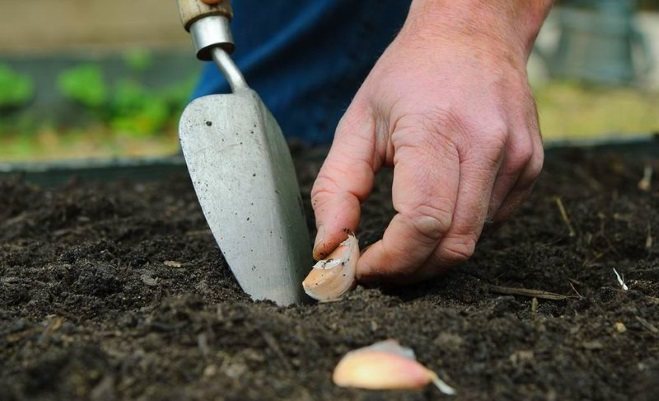

Crop rotation rules
Compliance with the rules of crop rotation will prevent not only soil depletion, but also the likelihood of fungal diseases affecting garden crops, therefore, garlic is not recommended to be grown on one site for more than 2 years in a row. You can plant it again on the same site after 4 years.
| Best Antecedent Cultures | Acceptable antecedents | Unfavorable antecedents | Vegetables to plant after garlic |
| Early ripening cabbage varieties | Late maturing cabbage varieties | Garlic | Cabbage |
| Cucumbers | Nightshade | Oats | Nightshade |
| Zucchini and other pumpkin | Garden strawberries and strawberries | Greens | Legumes |
| Beans and legumes | Barley | Pumpkin | |
| Melons | Spinach | Rape | |
| Wheat | Roots | Rye | |
| Rye | Phacelia | ||
| Forage grasses |

